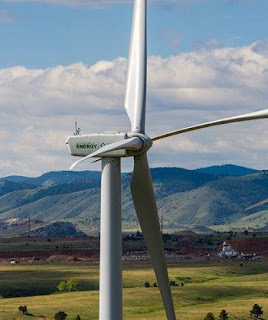How Wind Turbine Works -
Wind turbines work on a simple principle: instead of using electricity to make wind—like a fan—wind turbines use wind to make electricity. Wind turns the propeller-like blades of a turbine around a rotor, which spins a generator, which creates electricity.
Wind is a form of solar energy caused by a combination of three concurrent events:
- The sun unevenly heating the atmosphere.
- Irregularities of the earth's surface.
- The rotation of the earth.
Wind flow patterns and speeds vary greatly across the United States and are modified by bodies of water, vegetation, and differences in terrain. Humans use this wind flow, or motion energy, for many purposes: sailing, flying a kite, and even generating electricity. The terms "wind energy" and "wind power" both describe the process by which the wind is used to generate mechanical power or electricity. This mechanical power can be used for specific tasks (such as grinding grain or pumping water) or a generator can convert this mechanical power into electricity.
A wind turbine turns wind energy into electricity using the aerodynamic force from the rotor blades, which work like an airplane wing or helicopter rotor blade. When wind flows across the blade, the air pressure on one side of the blade decreases. The difference in air pressure across the two sides of the blade creates both lift and drag. The force of the lift is stronger than the drag and this causes the rotor to spin. The rotor connects to the generator, either directly (if it’s a direct drive turbine) or through a shaft and a series of gears (a gearbox) that speed up the rotation and allow for a physically smaller generator. This translation of aerodynamic force to rotation of a generator creates electricity.
Types of Wind Turbines
Modern wind turbines fall into two basic groups:
HORIZONTAL-AXIS TURBINE
Horizontal-axis wind turbines are what many people picture when thinking of wind turbines. Most commonly, they have three blades and operate "upwind," with the turbine pivoting at the top of the tower so the blades face into the wind.
Horizontal Axis WTG
VERTICAL-AXIS TURBINES
Vertical-axis wind turbines come in several varieties, including the eggbeater-style Darrieus model, named after its French inventor. These turbines are omnidirectional, meaning they don’t need to be adjusted to point into the wind to operate.
Wind turbines can be built on land or offshore in large bodies of water like oceans and lakes. The Indian Department of Energy is currently funding projects to facilitate offshore wind deployment in Indian waters.
How does a wind turbine work
2. The Rotors spin around, capturing some of the kinetic energy from the wind, and turning the central drive shaft that supports them. Although the outer edges of the rotor blades move very fast, the central axle (drive shaft) they're connected to turns quite slowly.
3. In most large modern turbines, the rotor blades can swivel on the hub at the front so they meet the wind at the best angle (or "pitch") for harvesting energy. This is called the pitch control mechanism. On big turbines, small electric motors or hydraulic rams swivel the blades back and forth under precise electronic control. On smaller turbines, the pitch control is often completely mechanical. However, many turbines have fixed rotors and no pitch control at all.
4. Inside the Nacelle (the main body of the turbine sitting on top of the tower and behind the blades), the Gearbox converts the low-speed rotation of the drive shaft (perhaps, 16 revolutions per minute, rpm) into high-speed (perhaps, 1600 rpm) rotation fast enough to drive the generator efficiently.
5. The Generator, immediately behind the gearbox, takes kinetic energy from the spinning drive shaft and turns it into electrical energy. Running at maximum capacity, a typical 2MW turbine generator will produce 2 million watts of power at about 700 volts.
6. Anemometer (automatic speed measuring devices) and wind vanes on the back of the nacelle provide measurements of the wind speed and direction.
7. Using these measurements, the entire top part of the turbine (the rotors and nacelle) can be rotated by a yaw motor, mounted between the nacelle and the tower, so it faces directly into the oncoming wind and captures the maximum amount of energy. If it's too windy or turbulent, brakes are applied to stop the rotors from turning (for safety reasons). The brakes are also applied during routine maintenance.
8. The electric current produced by the generator flows through a cable running down through the inside of the turbine tower.
9. A step-up transformer converts the electricity to about 50 times higher voltage so it can be transmitted efficiently to the power grid (or to nearby buildings or communities). If the electricity is flowing to the grid, it's converted to an even higher voltage (130,000 volts or more) by a substation nearby, which services many turbines.
10.Homes enjoy clean, green energy: The Turbine has produced no greenhouse gas emissions or pollution as it operates.
1.Nacelle
a)Gear Box.
b)Generator
2.Blades
3.Tower
4.Transformer
For House hold small type of Wind turbines i will share in next article.




Comments